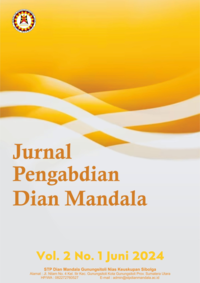Rekayasa Bahan Bangunan dari Abu Vulkanik sebagai Alternatif Semen Ramah Lingkungan
DOI:
https://doi.org/10.62200/jpdm.v3i1.227Keywords:
Biomechanics, Body Angle, Drag Coefficient, Propulsion Force, SwimmingAbstract
This study aims to analyze the effect of variations in body angle on propulsion force and water resistance in swimming athletes through a biomechanical approach. The background of the study is based on the importance of movement efficiency in swimming, where a less than optimal body position can increase the drag coefficient, thereby slowing swimming speed. The research method uses a quantitative experimental design involving professional and semi-professional level swimmers. The instruments used include a motion capture system to record body movements, force sensors to measure propulsion and water resistance, and biomechanical software to analyze force vectors and drag coefficients. The results show significant differences in swimming performance based on variations in body angle. At an angle of 0°, the average propulsion force generated is 145.3 N with a drag coefficient of 0.92. At an angle of 15°, the propulsion force increases to 162.7 N with the lowest drag coefficient of 0.78. Meanwhile, at an angle of 30°, the propulsion force decreases to 150.1 N with the drag coefficient again increasing to 0.88. These findings demonstrate that a 15° body angle is the most optimal position because it minimizes water resistance while maximizing propulsion, thereby increasing swimming efficiency. The implications of this study suggest that a biomechanical approach can be used as a reference in planning swimming training programs. In addition to contributing to the development of sports science, the results of this study also have practical benefits for athletes and coaches in developing more effective training strategies. Future research is recommended to expand the sample size and include various swimming styles to strengthen the generalizability of the results.
References
Al-Majnoni, A., Al-Sahli, J., Al-Ahmady, D., Al-Mutairi, A., Alsini, A., & Alharbi, M. (2025). Moar: A swimmer motion swimming style identification model using deep learning. Engineering, Technology and Applied Science Research, 15(1), 19295–19302. https://doi.org/10.48084/etasr.9309
Appel, A., Tandon, K., Küppers, U., & Stengel, T. (2025). Effect of volcanic ash used as supplementary cementitious materials on mortar strength and durability. In Lecture Notes in Civil Engineering (Vol. 573, pp. 340–347). Springer. https://doi.org/10.1007/978-3-031-80672-8_41
Du, J.-B., Wei, L.-C., & Zhu, J.-H. (2025). Swimming pose recognition based on inertial sensor and CNN-SVM. Journal of Network Intelligence, 10(3), 1914–1928. https://www.scopus.com/inward/record.uri?eid=2-s2.0-105014632078
Fernandes, A., Costa, M. J., Mezêncio, B., Vilas-Boas, J. P., & Fernandes, R. J. (2024). Breaststroke and butterfly intercycle kinematic variation according to different competitive levels with statistical parametric mapping analysis. Journal of Biomechanics, 176, 112380. https://doi.org/10.1016/j.jbiomech.2024.112380
Guru Kumar, M. S., Balasubramanian, M., & Arul Jeya Kumar, A. (2020). Application of FGC blocks for sustainable infrastructure development. IOP Conference Series: Materials Science and Engineering, 912(6), 062057. https://doi.org/10.1088/1757-899X/912/6/062057
Hasan, M. S., Karmokar, J., & Mahmood, S. M. F. (2024). Strength and workability of concrete incorporating volcanic ash as a partial replacement for cement. In Lecture Notes in Civil Engineering (Vol. 512, pp. 251–258). Springer. https://doi.org/10.1007/978-3-031-63280-8_26
Hossain, M. U., Cai, R., Ng, S. T., Xuan, D., & Ye, H. (2021). Sustainable natural pozzolana concrete: A comparative study on its environmental performance against concretes with other industrial by-products. Construction and Building Materials, 270, 121429. https://doi.org/10.1016/j.conbuildmat.2020.121429
Játiva, A., & Etxeberria, M. (2024). Exploring the utilization of activated volcanic ash as a substitute for Portland cement in mortar formulation: A thorough experimental investigation. Materials, 17(5), 1123. https://doi.org/10.3390/ma17051123
Játiva, A., Ruales, E., & Etxeberria, M. (2021). Volcanic ash as a sustainable binder material: An extensive review. Materials, 14(5), 1302. https://doi.org/10.3390/ma14051302
Kaptan, K., Cunha, S., & Aguiar, J. (2024). A review: Construction and demolition waste as a novel source for CO₂ reduction in Portland cement production for concrete. Sustainability, 16(2), 585. https://doi.org/10.3390/su16020585
Liu, C., Hao, W., & Huo, B. (2023). Advances and challenges in sports biomechanics [运动生物力学发展现状及挑战]. Advances in Mechanics, 53(1), 198–238. https://doi.org/10.6052/1000-0992-22-030
Liu, H., & Wang, X. (2022). Analysis of the influence of physical training on skeletal structure based on biomechanical analysis. International Journal of Nanotechnology, 19(6–11), 983–998. https://doi.org/10.1504/IJNT.2022.128981
Nicol, E., Adani, N., Lin, B., & Tor, E. (2024). The temporal analysis of elite breaststroke swimming during competition. Sports Biomechanics, 23(10), 1692–1704. https://doi.org/10.1080/14763141.2021.1975810
Ricciotti, L., Lucariello, D., Perrotta, V., Apicella, A., & Aversa, R. (2025). Sustainable alkali-activated and geopolymer materials: What is the future for Italy? Recycling, 10(4), 140. https://doi.org/10.3390/recycling10040140
Tran, C. N. N., Illankoon, I. M. C. S., & Tam, V. W. Y. (2025). Decoding concrete’s environmental impact: A path toward sustainable construction. Buildings, 15(3), 442. https://doi.org/10.3390/buildings15030442
Valentini, L., Favero, M., & Marangu, J. M. (2025). Formulation of sustainable cements with Kenyan volcanic ashes. In RILEM Bookseries (Vol. 55, pp. 275–281). Springer. https://doi.org/10.1007/978-3-031-70277-8_32
Villarreal-Centurión, L. E., Soriano, L., Payá, J., Borrachero, M. V., Monzó, J. M., & Gimenez-Carbó, E. (2025). Effect of volcanic ash and a C-S-H nano-additive on the manufacture of cementitious systems. Construction and Building Materials, 489, 142191. https://doi.org/10.1016/j.conbuildmat.2025.142191
Wang, M., & Pei, Z. (2024). Injury prevention and rehabilitation strategies in physical education: A machine learning-based approach using biomechanical characteristics. MCB Molecular and Cellular Biomechanics, 21(2), 412. https://doi.org/10.62617/mcb.v21i2.412
Downloads
Published
How to Cite
Issue
Section
License
Copyright (c) 2025 Jurnal Pengabdian Dian Mandala

This work is licensed under a Creative Commons Attribution-ShareAlike 4.0 International License.










